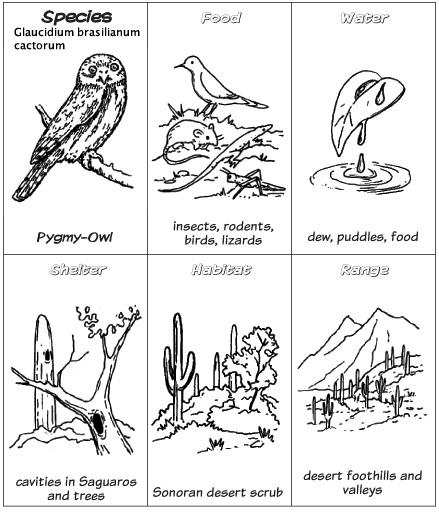

Directions: Print two copies of the card, then select the remaining cards from the Learning Materials menu.


Cactus Ferruginous Pygmy Owl - Glaucidium brasilianum cactorum
Description: The cactus ferruginous pygmy-owl is a small bird, about 6.5 inches in length and weighing 2.5 ounces. The owl is reddishbrown with a cream-colored striped belly. The crown is lightly streaked and the eyes are yellow. The owl has a relatively long tail and no ear tufts. This owl is active in the daytime.
Habitat: In the Sonoran desert scrub, the owl can be found in associations of ironwood, paloverde, mesquite, acacia, bursage, and columnar cactus such as saguaro and organ pipe. Typical throughout these habitats are fairly dense woody thickets with trees and cacti large enough to provide nesting cavities. In riparian areas, cottonwood trees were are for nesting.
Range: Desert foothills and valleys from central Arizona to the states of Colima and Michoacan, Mexico. An eastern population ranges from southern Texas, into the states of Tampulipas and Nuevo Leon, Mexico.
Diet: The owl is an opportunistic predator feeding on what is available. The prey ranges from insects and rodents to birds and lizards.
Reproduction: The cactus ferruginous pygmy owl nests in cavities in trees or cacti such as the organ pipe or saguaro. The pygmy owl begins nesting activity late winter to early spring. Three to five eggs are laid in late April-May. The eggs are incubated for about twenty-eight days. The young are fed by both parents. The young fledge twenty-seven to thirty days after hatching.
Status: The cactus ferruginous pygmy owl is listed as endangered. At one time, the pygmy owl was of common occurrence in southern Arizona. Today, the owl numbers are very low, and until recently, very little was known about the owl. Some of the pygmy owls' habitat is found in the fastest growing areas of Tucson.
Sonoran Desert Conservation Plan • Pima County Administrator’s Office • 130 West Congress, 10th floor, Tucson, AZ 85701-1317 • Phone: 520-740-8661 • http://www.SDCPonline.org
Return to the Sonoran Desert Endangered Species Card Game

 Go to quick links
Go to quick search
Go to navigation for this section of the ToL site
Go to detailed links for the ToL site
Go to quick links
Go to quick search
Go to navigation for this section of the ToL site
Go to detailed links for the ToL site